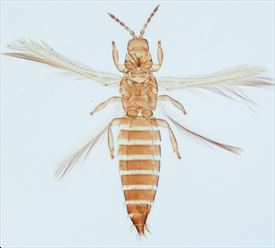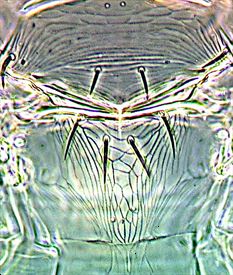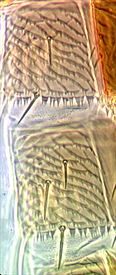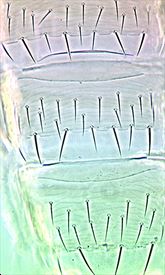Distinguishing features
Both sexes fully winged. Female colour variable, sometimes yellow, frequently bicoloured with abdomen brown and head and thorax paler; antennal segments I, III and base of IV yellow; legs yellow; fore wings pale. Antennae 7-segmented. Head transverse, ocellar setae III arise within triangle close to first ocellus. Pronotum with 4–5 posteromarginal setae, external postero-angular seta shorter than inner seta. Metanotum irregularly reticulate medially, median setae well behind anterior margin, campaniform sensilla present. Fore wing first vein with 3 or 4 setae on distal half. Abdominal tergite II with 3 lateral setae; tergite VIII comb represented by a few teeth laterally. Sternites III–VII with 15–25 discal setae, pleurotergites with 1–3 discal setae.
Male yellow; pleurotergites without discal setae; tergite VIII with no comb, IX with 4 setae arranged in transverse row.
Related species
The genus Thrips includes 13 species from New Zealand, out of a total of 280 species worldwide (Mound & Masumoto, 2005). Many of these species have the antennae clearly 7-segmented, whereas others have 8 segments. All members of Thrips genus have paired ctenidia on the tergites, and on tergite VIII these are postero-mesad to the spiracles, and they also lack ocellar setae pair I in front of the first ocellus. In contrast, Frankliniella species have ctenidia on tergite VIII antero-lateral to the spiracles, and a pair of setae is always present in front of the first ocellus. T. imaginis is very similar to T. safrus in having unusually large numbers of discal setae on the sternites, but it also has discal setae on the pleurotergites whereas these are absent in safrus.
Biological data
Feeding and breeding in the flowers of many unrelated plant species, this thrips was considered a serious pest of pome fruits in Australia in the 1930s, but is rarely of great significance on any crops in recent years.
Distribution data
This species has been collected infrequently in New Zealand (SD, NN). Individuals are presumably wind-dispersed irregularly from Australia, but large populations fail to develop. It is endemic and widespread across southern Australia and Tasmania, and has been recorded from Lord Howe Island and New Caledonia.
Family name
THRIPIDAE, THRIPINAE
Species name
Thrips imaginis Bagnall
Original name and synonyms
Thrips imaginis Bagnall, 1926: 111
Thrips imaginis apicalis Bagnall, 1926: 111
Thrips fortis Bagnall, 1926: 109
Thrips shakespearei Girault, 1927: 1
Neophysopus io Girault, 1927: 1
Neophysopus aureolus Girault, 1928: 3
Aptinothrips apertus Kelly & Mayne, 1934: 33
References
Mound LA & Masumoto M (2005) The genus Thrips (Thysanoptera, Thripidae) in Australia, New Caledonia and New Zealand. Zootaxa 1020: 1–64.
Mound LA, Tree DC & Paris D (2012) OzThrips – Thysanoptera in Australia. http://www.ozthrips.org/
Mound LA & Walker AK (1982) Terebrantia (Insecta: Thysanoptera). Fauna of New Zealand 1: 1–113.





